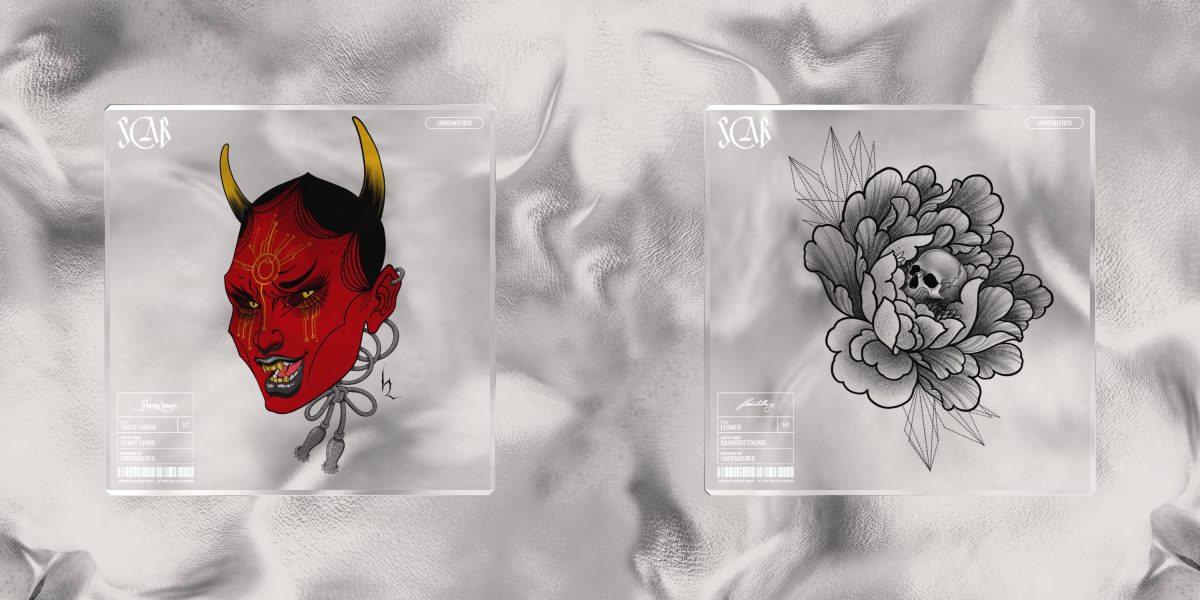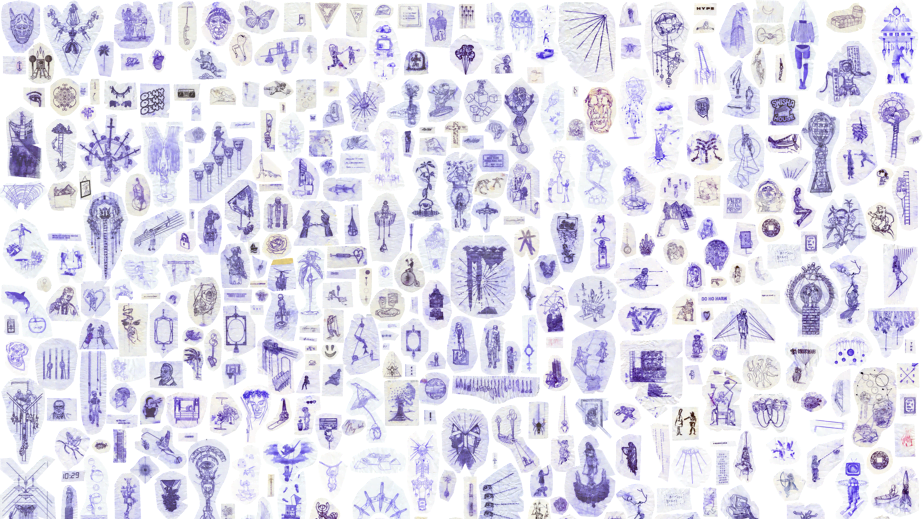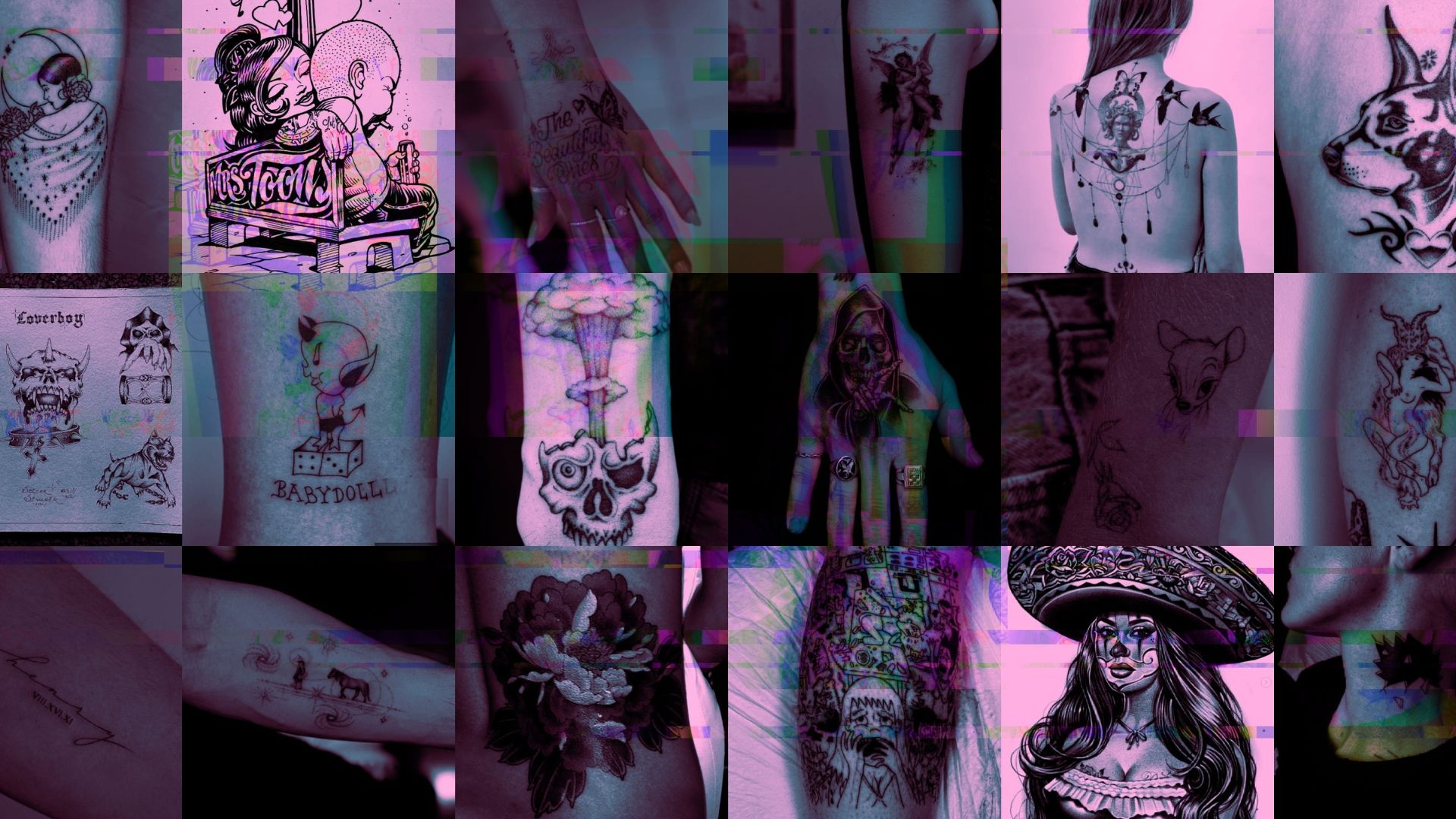When we die, what happens to our tattoos? Are pictures the only viable way to commemorate the beautiful, sentimental, and often expensive pieces of art that we have permanently affixed to our skin? Of course, you could have someone remove your flesh to preserve your tattoos, which is a process that happens more often than you’d think. But placing a piece of your loved one’s body on display might be a bit too macabre for most.
So what is the best method for maintaining the legacy of someone’s tattoos? Asking your artist for a physical or digital version of the initial mockup is always an option. But why keep an extra copy of something that’s literally attached to you? The real deal probably looks much cooler on your body anyways.
Tattoos have permanence, but nearly every attempt at preserving them seems somehow temporary, even fleeting. There needs to be a more robust way to hold onto both the image and experience that comes with getting a tattoo. And in 2022, we have ways to digitize and immortalize them, namely; tattoo NFTs.
Are tattoo NFTs really a thing?
The short answer is: yes. Tattoo NFTs are most definitely a thing. But they are a bunch of different things at the same time. Much like how “generative art” encompasses a broad variety of methods and use cases, “tattoo NFTs” are also, for the most part, a blanket term.
Some tattoo NFTs start as physical pieces before being digitized. Others exist as digital art NFTs imbued with real-world utility. And others still are simply tradeable tattoo-style tokens. The world of tattoo NFTs is both diverse and sparse at the same time, and that’s because this sector of Web3 remains broadly underpopulated.
For now, the tattoo NFT market is a wild west. Countless tattoo artists may be interested in Web3, but few yet have taken the steps to fully venture into non-fungibles. Those who do seek to bring their unique styles onto the blockchain often must do so in unprecedented ways.
Some opt for releasing 1/1s, or editions, while others prefer generative collections. But each case capitalizes on the digital nature of their creative process. Others, like Scott Campbell, have even created entire marketplaces for tattoo NFTs, further expanding the budding ecosystem. Even beyond individualistic undertakings, tattoos are being collated and incubated into a type of digital wearable. Currently, there are a few projects, like Swallow, that are in the early stages of attempting to enable Web3 communities to show off tattoos on the “skin” of their metaverse avatars.

Yet, despite the slow growth of the tattoo NFT market, this sector could surely still be characterized as just a wide range of unconnected one-offs. But it would be illogical to overlook the trend that is clearly emerging. And to truly understand what tattoo NFTs are and what they could be, we must first understand who’s behind them.
Tattoo artists versus tattoo NFT creators
An important distinction must be made in considering those who have ventured into tattoo NFTs. While many (if not all) within this budding sector are seasoned tattoo artists, they are, first and foremost, simply artists. Much can be said about the art form and practice of tattooing, but it’s rare to come across a tattoo artist whose sole medium is free-handing. For tattoos to be conceptualized and created, creativity must exist in other forms.
For many tattoo artists, this creativity exists through illustration — in digital form, or using a pen or pencil and paper. Before ideas can become a reality, they go through the iterative art process. Whether it concerns creating flash (pre-made designs) or penning a custom design for a client, artists utilize their unique skills to give their inspiration an outlet.
In considering what differentiates the tattoo NFT sector from others, let’s take Gossamer Rozen as an example. Now a prominent name in the NFT space, before becoming notable on the blockchain, they practiced several artistic disciplines, eventually gaining a following as a tattoo artist. Even at the beginning of their Web3 career, their identity as a tattoo artist helped shape their pathway to success.
Through collections like Squishin Kitties, Internet Graffiti, and TZttoo (see what they did there), Rozen effectively transferred their skills as an illustrator and tattoo artist into their NFT endeavors. While they also attempted to bring their multitude of disciplines (like sculpting) into Web3, it was tattoo NFTs that stuck first.
By creating a crossover between their crypto-art efforts and real-life incentives, Rozen found themself at an incredibly unique and niche intersection in the NFT ecosystem. While the link between physical and digital goods had just begun to emerge through metaverse fashion and IRL garments, Rozen was one of the first to bridge the blockchain and meatspace gap by allowing a collector of theirs to redeem a Squishin Kitty NFT for a tattoo.
“The reason why I was able to make it happen was that the collector and I got to know each other and we talked about it ahead of time,” Rozen said in an interview with nft now. “So there was kind of a vetting process in place, because we both decided this is what we wanted.” Although this event was somewhat of an outlier for Rozen, it undoubtedly helped solidify the possibilities for tattoo NFTs.
Collectible limited series “SQUISHIN KITTIES!” available, 6 more designs dropping soon! At 0.07 ETH 🥰💖🐯💕❤️🌺 inspired by tattoos and street art🍑🐠🐸🐷🐤 https://t.co/7ot02zG1iT pic.twitter.com/6Xgd3dFcuV
— Gossamer Rozen 🐯 NYC (@grelysian) April 6, 2021
It’s easy now to look back at Rozen’s early endeavors and see why tattoo NFTs are unique from other forms of NFTs. Truly, it’s the tattoo factor that gives them their distinctive characteristics. Just as generative avatars are known for their use as profile pictures and photography NFTs are set apart from the pack as a burgeoning form of tokenized nostalgia, tattoo NFTs cannot be grouped with the general population of digital collectibles.
To Rozen, the mix of tattoos and NFTs is a comment on the permanent nature of both. Speaking about their own tattoo x NFT projects, Rozen made the point that tattoo NFTs are in fact permanent tattoos. “They are permanently minted on the blockchain. So in that way, it mirrors how tattoos are permanent on a human being in the real world. Marrying those two things was always on my mind,” Rozen said.
Ultimately, Rozen’s endeavors in the tattoo x NFT sector took a pause as they hit their stride in Web3, going on to create an IP empire around their beloved tiger character. But the link they helped solidify with their early pieces can still serve as an archetype to many of the tattoo NFT projects that continue to emerge.
When we delve further into the tattoo NFT space, undertakings like Campbell’s aforementioned Scab Shop — an exclusive curated platform that lets NFT collectors redeem tokens for tattoo appointments with some of the world’s most renowned artists — also serve to illustrate the developing nature of tattoo NFTs. Surely, the line between NFTs and IRL utility is interesting. And it isn’t the sole use case of tattoo NFTs. But even so, the sector has struggled to gain a foothold in the greater NFT market.
Why aren’t tattoo NFTs more common?
The individualistic element of tattoo NFTs has made the sector, as a whole, difficult to track. While numerous tattoo NFT projects have come and gone throughout 2021 and 2022, there there are no popular hubs for creating and collecting tattoo NFTs. At least, not like music or street art NFTs have.
Similarly, there are no popular frameworks or even well-known best practices surrounding tattoo NFTs to help creators strategize success in a systematized way. In light of this, compounded by the fact that “tattoo NFT” is such a blanket term, many tattoo NFT collections miss out on being labeled a part of this larger trend or even circulated within relevant communities and spaces.
Due to an apparent lack of sustained interest in tattoo NFTs, which could be linked to the absence of profitability in the sector (as opposed to music, photography, or even generative NFTs), creators at the intersection of tattoos and NFTs often find themselves moving away from the sector over time. Then again, it could be a lack of interest in showcasing their other skills and talents in Web3 that lead them beyond being pigeonholed into tattoo NFTs.
One tattoo artist that fits this bill is Snuffy. When the renowned New York-based tattoo artist Snuffy first entered the NFT space, he took a somewhat similar path to Rozen. With his first few releases, he offered collectors the ability to redeem their NFTs for physical tattoos. Yet he soon realized that the potential of NFTs, for him, didn’t lie solely in tattooing.
“If I make a piece of art and you hang it on your wall, that piece of art can go and be sold for $10 million. I can charge a much higher price for that piece of art vs. art I put on your skin. Because when I put it on your skin, it’s not a commodity,” Snuffy said in an interview with nft now. “NFTs have turned my tattoos into a commodity. Whereas before it was a commodity only for the owner of the tattoo.”
Leaning into this commodified blueprint, Snuffy went on to transform the first 555 tattoos he ever completed into an NFT collection. But as his catalog grew, he stepped further away from the intersection of tattoos and NFTs, venturing into several blockchain and IRL exhibitions and installations that have helped present his works as the unique creations they are. While he is still known for his tattoo work, these days he is seen, in Web3, as more of an innovative fine artist than a tattoo NFT creator.

As illustrated further by the endeavors of world-renowned tattoo artist Trudy Lines, NFTs are promising but still somewhat elusive to many. In Trudy’s case, the influential creator aimed to combine movement and computer coding together with ambient audio to generate NFTs in the form of smoke particle simulation. Her collection Movement of Mind felt like an extension of her creative prowess, but lacked the tattoo-leaning factor that many of her fans might’ve expected, which Trudy says was kind of the point.
“I didn’t want to have a tattoo design and just turn it into an NFT… I think some [tattoo artists] are probably money motivated. They think ‘oh, there’s money in NFTs — let me put a design on-chain and sell it to multiple people,’” Trudy said in an interview with nft now. “I personally don’t even want to relate my tattoo NFTs too much to tattooing. [With NFTs] I saw a window to have my art outside of the tattoo world.”
Trudy, Snuffy, and Rozen’s path into Web3 shows that while clout and experience as a tattoo artist can help kickstart an NFT career, they likely cannot help sustain it. For artists, it surely seems only natural to lean into what works best on a professional level. This is precisely why many tattoo artists, like Trudy, seek space to create unique and sometimes grandiose endeavors when entering the NFT space. But a focus on innovation isn’t the only thing that will help push the tattoo NFT sector forward.
The case for a more robust tattoo NFT ecosystem
For tattoo NFTs to become a more sustainable part of the NFT ecosystem, we would need to see a boost in both innovation and infrastructure. There needs to be more to tattoo NFTs than rare collection launches and infrequent collaborative drops. A central hub for this sector would undoubtedly benefit both the creators and the collectors interested in the intersection of tattoos and NFTs.
Currently, platforms like Ethernaal seem to be a promising first attempt at what tattoo NFT marketplaces could look like. With Ethernaal, artists can convert their designs and flash into NFTs without any technological know-how. Similar to other prominent marketplaces, minting is simple and accessible on this non-exclusive platform.
Aside from Ethernaal and Scab Shop, there aren’t many other promising platforms looking to push the boundaries of tattoo NFTs. Additionally. building a new one may not be easy, considering the colossal amount of planning and effort required from both creators and developers. Perhaps the difficult nature of this undertaking is one of the reasons why there’s a disproportionate focus on innovation as it pertains to building out the tattoo x NFT sector.
While innovation is undoubtedly a driving force in the NFT space, it seems to almost be harmful to tattoo NFTs. As previously mentioned, tattoo artists like Snuffy and Rozen have innovated in their own careers and moved away from the tattoo x NFT sector in search of new horizons. Even those coming into the NFT space with innovative ideas, like Trudy Lines, are leaving their identities as tattoo artists off-chain.
This is why, for the tattoo x NFT space to truly flourish, infrastructure and innovation must go hand in hand. Innovation would need to come from builders and developers in the form of infrastructure and ease of use, leaving room for artists to iterate down the line. Surely this is possible in Web3, but for now, we’ve yet to see it happen.
Read More: nftnow.com









 Vana
Vana  PAX Gold
PAX Gold  Polygon PoS Bridged WETH (Polygon POS)
Polygon PoS Bridged WETH (Polygon POS)  Dash
Dash  Trust Wallet
Trust Wallet  Creditcoin
Creditcoin  Ether.fi
Ether.fi  Goatseus Maximus
Goatseus Maximus  Astar
Astar  PayPal USD
PayPal USD  Telcoin
Telcoin  TrueUSD
TrueUSD  GRIFFAIN
GRIFFAIN  Theta Fuel
Theta Fuel  io.net
io.net  Stader ETHx
Stader ETHx  Usual
Usual  AgentFun.AI
AgentFun.AI  Swell Ethereum
Swell Ethereum  BOOK OF MEME
BOOK OF MEME  CHEX Token
CHEX Token  Zerebro
Zerebro  Swarms
Swarms  Zilliqa
Zilliqa  Moca Network
Moca Network  WOO
WOO  Holo
Holo  tBTC
tBTC  Super OETH
Super OETH  0x Protocol
0x Protocol  Horizen
Horizen  JUST
JUST  Ondo US Dollar Yield
Ondo US Dollar Yield  Neiro
Neiro  Enjin Coin
Enjin Coin  GMT
GMT  Magic Eden
Magic Eden  Aethir
Aethir  Golem
Golem  Bridged USDC (Polygon PoS Bridge)
Bridged USDC (Polygon PoS Bridge)  AI Rig Complex
AI Rig Complex  Convex Finance
Convex Finance  QuantixAI
QuantixAI  DeepBook
DeepBook  Celo
Celo  Basic Attention
Basic Attention  Verus
Verus  Memecoin
Memecoin  Ankr Network
Ankr Network